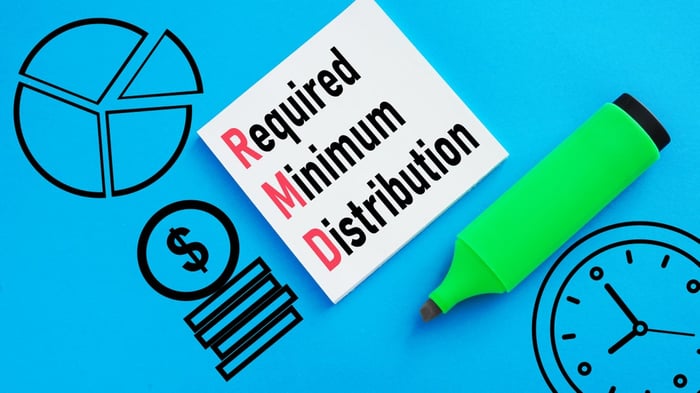Key Points
-
The most common way to use required minimum distributions is to cover everyday living expenses.
-
If you don’t require the money to cover living expenses, consider paying down any lingering debt.
-
RMDs that exceed the amount needed to pay bills can be put to good use as part of an emergency fund.
Ah, required minimum distributions (RMDs), Uncle Sam’s way of telling you it’s time to pay taxes on the pre-tax contributions to your retirement account. To collect taxes, the IRS has designated a year in which you must start withdrawing a minimum amount. For many, the age is 73, although you can wait until 75 if you were born in 1960 or later.
If you made contributions to any of these accounts, RMDs may already have become part of your life:
Where to invest $1,000 right now? Our analyst team just revealed what they believe are the 10 best stocks to buy right now. Learn More »
- 401(k)
- 403(b)
- 457(b)
- Traditional IRA
- SIMPLE IRA
- SEP IRA
- Defined contribution plan
- Profit-sharing plan

Image sources: Getty Images.
Strategic ways to make the most of your RMDs
It’s your money to spend any way you’d like, but if you’re looking for a few fresh ideas, here are six worth considering.
1. Cover living expenses
It’s fair to assume that many retirees count on RMDs to pay everyday living expenses, and if that’s something you do, keep it up. After all, that’s one reason you worked so hard to build a retirement account and it may play a large role in your overall retirement plan.
As you budget for the year, don’t forget to add emergency expenses (in case you don’t have an emergency fund) and healthcare costs.
2. Pay down debt
Few things are more frustrating than paying high interest to a faceless credit card company. If you’re still lugging around high-interest debt and can afford to pay your living expenses, consider using your RMD to jettison debt.
If you still have a mortgage, you can also use a portion of your RMD to pay it down. That way, if you ever need a home equity loan or reverse mortgage, there’s more equity available.
3. Plump up your emergency fund
Unless you have more money than you need in an emergency fund, it’s a good idea to fatten the account up a bit. The goal is never to have to dip into your retirement fund or put an emergency expense on a credit card when an unexpected situation arises.
There are plenty of places to keep emergency funds. Take a look at the current rates on high-yield savings accounts (HYSAs), money market accounts (MMAs), or certificate of deposits (CDs).
4. Don’t forget about an asset buffer
Historically, the stock market enjoys far more peaks than valleys. However, when hard times strike and the market drops by 20% or more from its most recent high, you know the U.S. has entered a bear market.
During a bear market, you want to avoid withdrawing more than you must from your retirement account. Whether it’s a 401(k), IRA, or some other type of pre-tax account, the depressed prices associated with a bear market mean you’ll have to sell more of your portfolio assets to withdraw the money you need. And the more assets sold, the less you have in your portfolio to buy up the bargain-priced stocks left behind by investors who sold at the first sight of trouble.
That’s where an asset buffer comes in. You can draw from it instead of dipping into your retirement account and potentially lose out on the profits earned as the market recovers.
5. Reinvest
There may be a rule saying when you “must” take your RMDs, but there’s no rule saying you can’t turn around and reinvest the money (once you’ve paid taxes on it, of course). Just as you did when you were working, focus on building a diversified portfolio that doesn’t leave you with all your eggs in one basket and open to risk.
Consider using the funds from your RMD to invest in ETFs, dividend-paying stocks, or index funds.
6. Donate to charity
If you have one of the following account types and are 70 1/2 or older, you can make a qualified charitable donation (QCD). The most you’re eligible to donate in a calendar year across all charities is $108,000. If you’re married and file taxes jointly, your spouse can also donate up to $108,000 from their account. If you’re 73 or older and required to take RMDs, your QCD counts toward your annual requirement.
- Traditional IRA
- Rollover IRA
- Inherited IRA
- SEP IRA (inactive only)
- SIMPLE IRA (inactive only)
- Under certain circumstances, Roth IRAs
The frustrating thing about RMDs is that you must take them, whether you want to or not. On the other hand, you can be proud to have saved for the future.
The $23,760 Social Security bonus most retirees completely overlook
If you’re like most Americans, you’re a few years (or more) behind on your retirement savings. But a handful of little-known “Social Security secrets” could help ensure a boost in your retirement income.
One easy trick could pay you as much as $23,760 more… each year! Once you learn how to maximize your Social Security benefits, we think you could retire confidently with the peace of mind we’re all after. Join Stock Advisor to learn more about these strategies.
View the “Social Security secrets” »
The Motley Fool has a disclosure policy.






